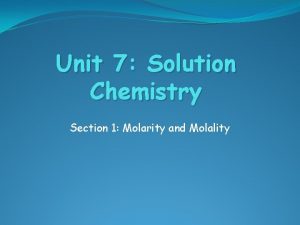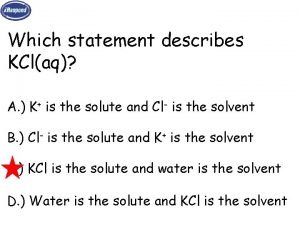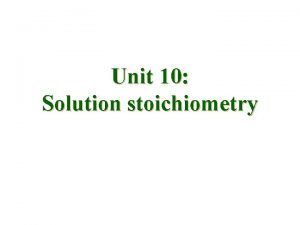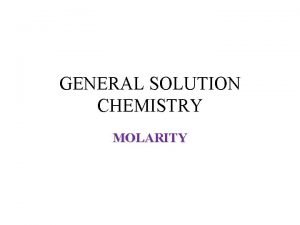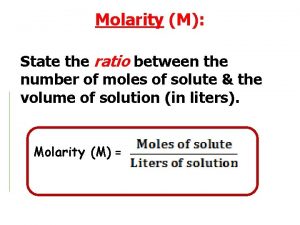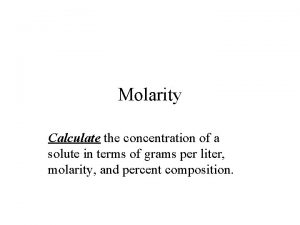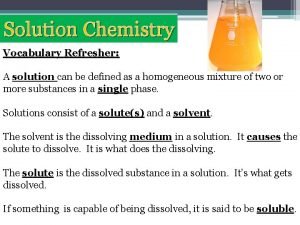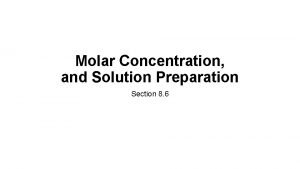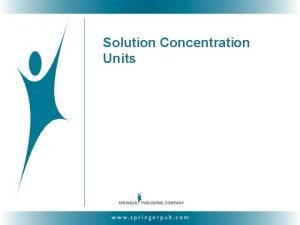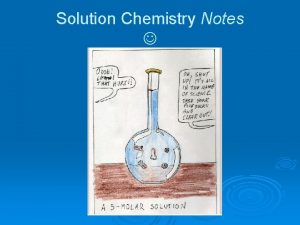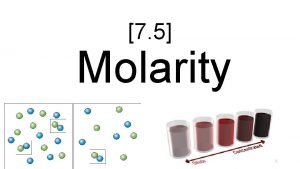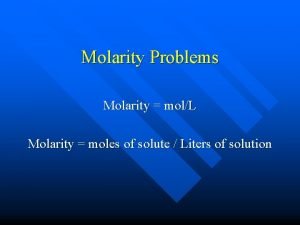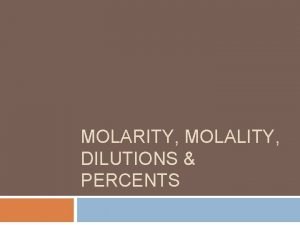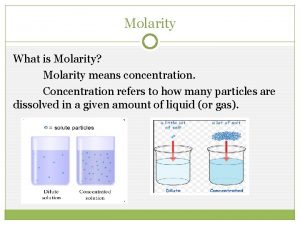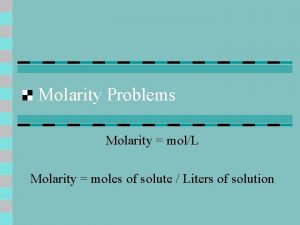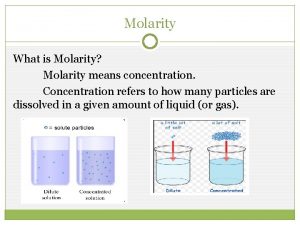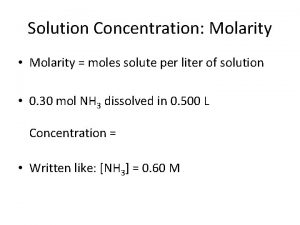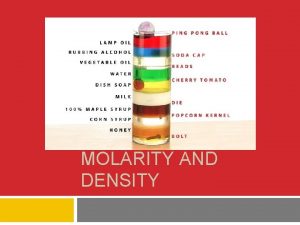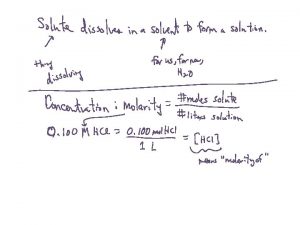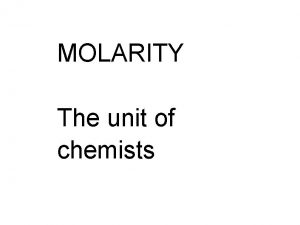Unit 7 Solution Chemistry Section 1 Molarity and












- Slides: 12

Unit 7: Solution Chemistry Section 1: Molarity and Molality

Solutions �Are a combination of at least two ingredients, such as water and salt �The substance in the larger quantity is the solvent �The substance in the smaller quantity is the solute �Are homogeneous mixtures �Don’t have to be liquids �Air is a solution composed of nitrogen (the solvent), oxygen, water vapor, carbon dioxide, and other gases �Brass is a solution composed of copper and zinc

Concentration �The higher the ratio of solute to solvent, the more concentrated the solution �Example: Kool-Aid can be as diluted or concentrated as you want it to be, just add more water to dilute the drink �The wrong concentration cause an object to work improperly or be harmful to living things �Example: Eye drops for humans can be harmful for a canine because of the different concentration requirements

Saturation �When the solute and solvent are put together, there is a limit as to how much solute can be dissolved �Saturated solution: no more solute will dissolve at a specific temperature �Unsaturated solution: more of the solute can be dissolved at the same temperature �Supersaturated solution: an unstable and temporary situation where the solution contains more dissolved solute than it normally would � Occurs when there is a change in temperature, volume, or pressure

Molarity (M) �The number of moles of solute per liter of solution �M = moles liter �Deals with concentration

Molarity Example 1 �What is the molarity of a solution made by dissolving 0. 3 mole of Ca(NO 3)2 in enough water to make 500 m. L of solution? M = moles liter = 0. 3 mol 0. 5 liter = 0. 6 M Ca(NO 3)2

Molarity Example 2 �How much 0. 5 M Na. Cl can be made from 0. 1 mole of Na. Cl? M = moles liter 0. 5 M = 0. 1 mole x liters 0. 5 x = 0. 1 x = 0. 2 L Na. Cl

Molarity Example 3 �What is the molarity of an Epsom salt (Mg. SO 4) solution made by dissolving 6 grams of it in enough water to make 2 liters of solution? �Step 1: convert grams to moles 6 g Mg. SO 4 x 1 mol Mg. SO 4 = 0. 05 mol Mg. SO 4 120. 366 g Mg. SO 4 �Step 2: M = moles liter M = 0. 05 mol = 0. 03 M Mg. SO 4 2 liters

Molarity Example 4 �How many grams of KOH are needed in order to prepare 2 liters of a 0. 25 M solution? �Step 1: M = moles liter 0. 25 M = x mol 2 L x = 0. 5 mol KOH �Step 2: convert moles to grams 0. 5 mol KOH x 56. 1049 g KOH = 30 g KOH 1 mol KOH

Molality (m) �The number of moles of solute per kilogram of solvent �m = moles of solute kilogram of solvent �Also deals with concentration, but used less frequently

Molality Example 1 �Calculate the molality of an antifreeze solution made by dissolving 186 g of antifreeze (C 2 H 6 O 2) in 2 kg of water. �Step 1: Convert grams to moles 186 g C 2 H 6 O 2 x 1 mol C 2 H 6 O 2 = 3. 00 mol C 2 H 6 O 2 62. 0674 g C 2 H 6 O 2 �Step 2: m = moles of solute kilogram of solvent m = 3. 00 mol = 2 m C 2 H 6 O 2 2 kg

Molality Example 2 �How many grams of lye (Na. OH) should be added to 800 g of water in order to make a 0. 5 m solution? �Step 1: Convert g of solvent to kg of solvent 800 g x 1 kg = 0. 8 kg 1000 g �Step 2: Solve for grams of solute m = moles of solute kilogram of solvent 0. 5 m = x mol = 0. 4 mol Na. OH 0. 8 kg �Step 3: Convert mol Na. OH to g Na. OH 0. 4 mol Na. OH x 39. 9959 g Na. OH = 20 g Na. OH 1 mol Na. OH
 Chemistry unit 7 molarity
Chemistry unit 7 molarity Which statement describe the solute
Which statement describe the solute Molarity units
Molarity units Molarity equation examples
Molarity equation examples Molar ratios
Molar ratios How to compute molarity
How to compute molarity Chemistry molarity
Chemistry molarity M in chemistry
M in chemistry Molarity unit
Molarity unit Molarity unit
Molarity unit Vapour pressure composition curve for non ideal solution
Vapour pressure composition curve for non ideal solution Difference between mixture and solution
Difference between mixture and solution Definition of solution in chemistry
Definition of solution in chemistry
